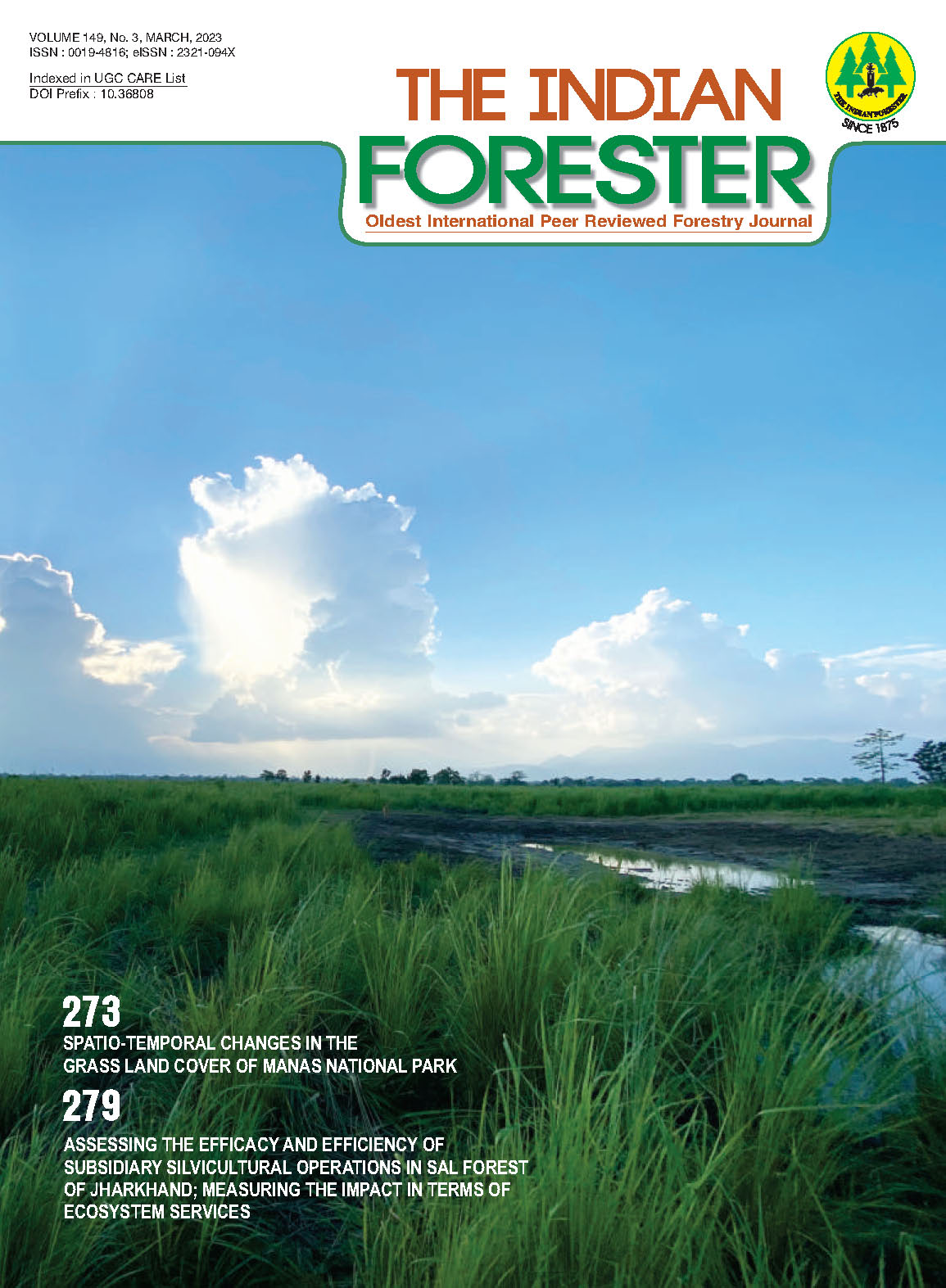Leaf and Shoot Growth Characteristics of Abies pindrow and A. spectabilis of West Himalaya
DOI:
https://doi.org/10.36808/if/2023/v149i3/164024Keywords:
Abies spp., High Altitude, Leaf and Shoot Characteristics, West Himalaya, Climate Change.Abstract
In this article leaf and shoot growth characteristics of two fir species (A. pindrow and A. spectabilis) found in the high altitude zone of Tungnath (Uttarakhand) are described with an objective to identify them easily due to their almost similar morphology. The mean height of A. pindrow trees was markedly greater than A. spectabilis (40.3±1.80 vs. 27.7±1.15 m), and the tree height declined but tree CBH increased with the increasing altitude. Both shoot diameter and number of leaves per shoot were higher in A. spectabilis for both leader (mean= 4.2 vs. 6.0 mm) and lateral shoots (mean=3.1 vs.3.88 mm). The number of leaves per shoot in A. spectabilis (mean= 146) was two and half times more that in A. pindrow (mean= 65). The leaves of A. spectabilis were comparatively smaller (length= 2.50 cm), narrower (width= 0.19 cm) and thinner (thickness= 0.25 mm) than the leaves of A. pindrow (length= 4.6 cm), narrower (width= 0.23 cm) and thinner (thickness= 0.38 mm). Leaves (needles) of A. pindrow are acute and bifid at apex, and A. specatbilis leaves are rather smooth at apex and have two greyish bands on either side of shallow mid-rib.Leaf mass (0.006 vs. 0.01 g/leaf) and leaf area 2 (0.48 vs. 1.0 cm2 /leaf) was also higher for A. pindrow. The increasing leaf thickness with altitude has important implications for understanding the ability of these two important fir species to harvest sunlight and grow in the cold environment at high altitude to devise an appropriate forest management practices in the era of climate change.References
Basnet P. and Gaire N.P. (2017). Growth and dynamics of Abies spectabilis (D. Don.) with climate change at tree line ecotone in the Western Nepal Himalaya. In: Proceedings of an International Conference on "Wild Harvests, Governance and Livelihoods in Asia" 71-84 p.
Evans G.C. (1972). The Quantitative Analysis of Plant Growth (Vol.I). Univ. California Press.
Farjon A. (2018). The Kew review: Conifers of the world. Kew bulletin, 73(1): 1-16.
Gaire N.P., Fan Z.X., Bräuning A., Panthi S., Rana P., Shrestha A. and Bhuju D.R. (2020). Abies spectabilis shows stable growth relations to temperature, but changing response to moisture conditions along an elevation gradient in the central Himalaya. Dendrochronologia, 60: 125675.
Hooker J.D., Cathcart J.F. and Fitch W.H. (1855). Illustrations of Himalayan plants.
Joshi R., Sambhav K. and Singh S.P. (2018). Near surface temperature lapse rate for tree line environment in Western Himalaya and possible impacts on ecotone vegetation. Trop. Ecol., 59(2): 197-209.
Khanal N.R. and Rijal S.P. (2002). Tree ring chronology from Ganesh Himal Area, Central Nepal. Geothermal/dendrochronological paleoclimate reconstruction across eastern margin of Eurasia, 12-19.
Naudiyal N., Wang J., Ning W., Gaire N.P., Peili S., Yanqiang W. and Ning S. (2021). Potential distribution of Abies, Picea, and Juniperus species in the sub-alpine forest of Minjiang headwater region under current and future climate scenarios and its implications on ecosystem services supply. Ecol. Indic., 121: 107-131.
Pan S., Liu C., Zhang W., Xu S., Wang N., Li. Y. and Wang G. (2013). The scaling relationships between leaf mass and leaf area of vascular plant species change with altitude. PloS one, 8(10): e76872.
Press J.R., Shrestha K.K. and Sutton D.A. (2000). Annotated checklist of the flowering plants of Nepal. Natural History Museum Publications.
Rai I.D., Adhikari B.S., Rawat G.S. and Bargali K. (2012). Community structure along timberline ecotone in relation to micro-topography and disturbances in Western Himalaya. Notulae Scientia Biologicae, 4: 41–52.
Shao Y.Z., Zhang X.C., Phan L.K. and Xiang Q.P. (2017). Elevation shift in Abies Mill. (Pinaceae) of subtropical and temperate China and Vietnam-Corroborative evidence from cytoplasmic DNA and ecological niche modelling. Front. Plant Sci., 8: 578.
Sharma C.M., Mishra A.K., Tiwari O.P, Krishan R. and Rana Y.S. (2017). Effect of altitudinal gradients on forest structure and composition on ridge tops in Garhwal Himalaya. Energy Ecol. Environ., 2: 404-417.
Sigdel S.R., Wang Y., Camarero J.J., Zhu H., Liang E. and Peñuelas J. (2018). Moisture mediated responsiveness of treeline shifts to global warming in the Himalayas. Glob.Chang. Biol., 24(11): 5549-5559.
Singh S.P., Sharma S. and Dhyani P.P. (2019). Himalayan arc and treeline: distribution, climate change responses and ecosystem properties. Biol. Conserv., 28(1): 1997-2016.
Singh U., Phulara M., David B., Ranhotra P.S., Shekhar M., Bhattacharyya, Dhyani R., Joshi R. and Pal A.K. (2018). Static tree line of Himalayan silver fir since last several decades at Tungnath, Western Himalaya. Trop. Ecol., 59(2): 351–363, 2018.
Tiwari A., Fan Z.X., Jump A.S., Li S.F. and Zhou Z.K. (2017). Gradual expansion of moisture sensitive Abies spectabilis forest in the Trans-Himalayan zone of central Nepal associated with climate change. Dendrochronologia, 41: 34-43.
Tiwari A., Kunwar R.M., Bussmann R.W., Paniagua-Zambrana N.Y., Hussain W. and Abbasi A.M. (2020). Abies pindrow (Royle ex D. Don.) Royle Abies spectabilis (D. Don) Spach P inaceae. Ethnobotany of the Himalayas, 1-11.
Troup R.S. (1921). The Silviculture of Indian Trees, Vol-III, Oxford at the Clarendon Press. 1195p.
Zhang D, Rushforth K. and Katsuki T. (2011).Abies spectabilis.IUCN Red List of Threatened Species.
Zheng W.J. and Fu L.G. (1978). Journal Flora Reipublicae Popularis Sinicae (ed: Wu ZY). Beijing: Science Press. 55p.
Downloads
Downloads
Published
How to Cite
Issue
Section
License
Unless otherwise stated, copyright or similar rights in all materials presented on the site, including graphical images, are owned by Indian Forester.





